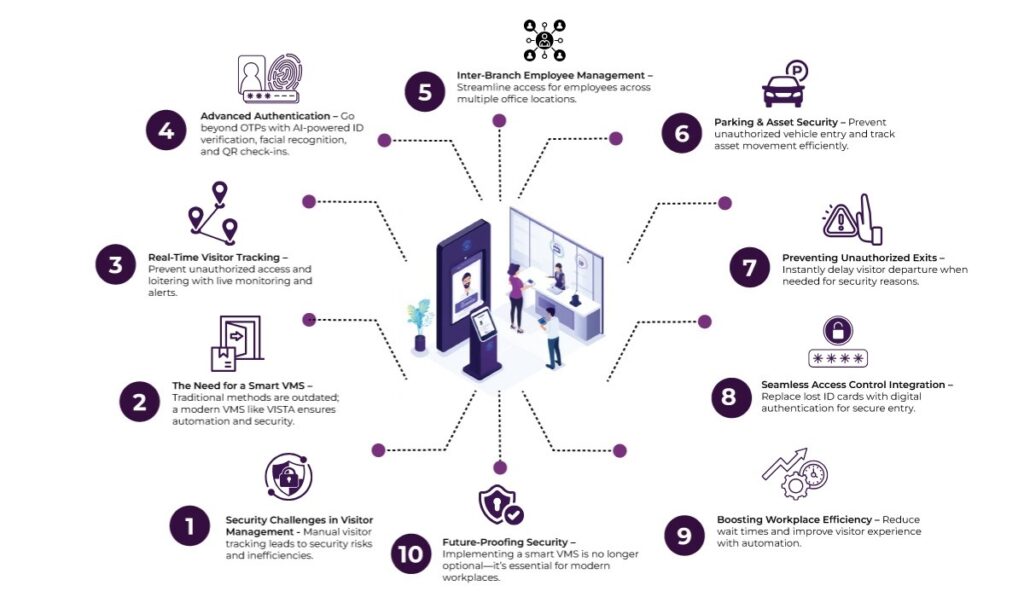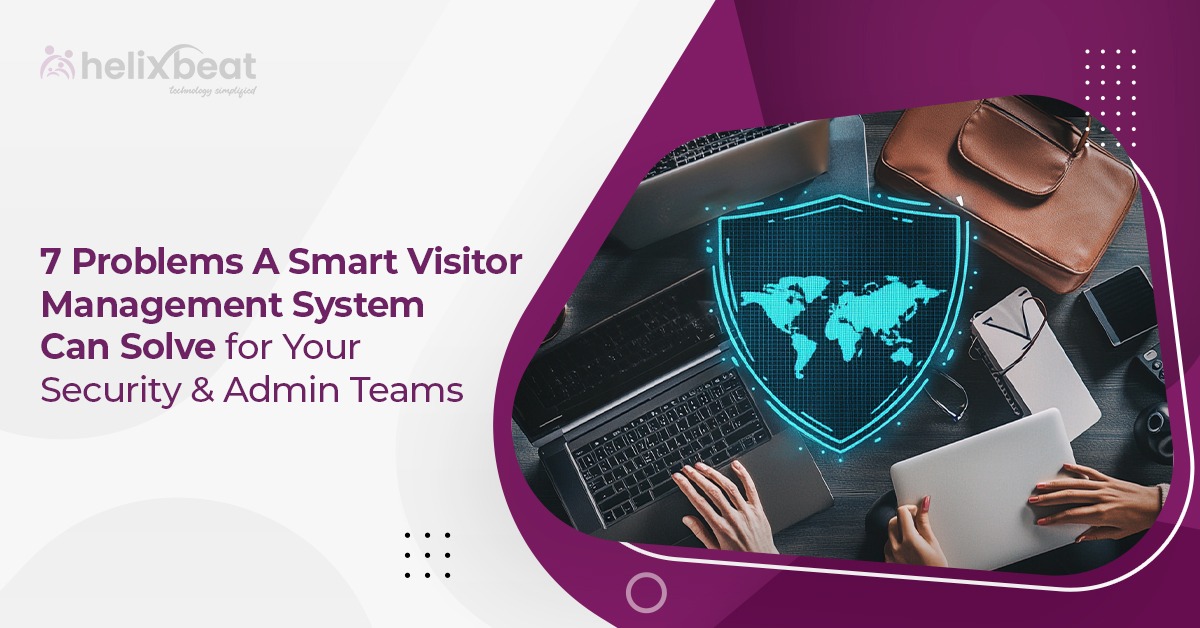No matter what type of business you’re in, your processes should solve real-world challenges that your teams face daily. With the automation and digitization of processes, expectations from teams are higher than ever. One such process is visitor management—a critical function for both administrative and security teams. A best visitor management system should not only address visitor-related administrative tasks but also complement the security system of your office premises.
Many of the visitor problems organizations face are common, day-to-day issues that can escalate into security concerns if left unaddressed. In our observation, teams across industries become so accustomed to handling these issues manually that they fail to realize solutions exist that can prevent potential security risks. Moreover, these solutions can save time, effort, and resources.
Several security gaps exist in manual visitor management processes, and basic VMSs are not equipped to handle these complex process challenges. However, VISTA, a smart visitor management system, has the capabilities to not only manage visitors but also prevent these loopholes. For example, consider a visitor who enters an office or facility and remains inside without proper tracking. This is a security risk that can be easily prevented with VISTA’s real-time tracking and alert system.
In this blog, we discuss seven critical issues that security and admin teams face on a daily basis—and how VISTA effectively resolves them.
Table of Contents
The Critical Role of a Visitor Management System for Security and Admin Teams
Security is a top priority for every organization, yet many still rely on outdated visitor management processes that leave gaps in protection. A 2023 study found that 63% of security breaches in workplaces were due to unauthorized individuals gaining access to restricted areas. Without an efficient best visitor management system (VMS), security teams face significant challenges in tracking, verifying, and controlling visitor movements.
Why a Manual System Falls Short
Traditional visitor logs, handwritten registers, and basic ID checks are no longer sufficient. These methods are prone to human error, easy to manipulate, and difficult to track in real-time. Consider these common issues:
- Fake or Forged ID Usage: A manual system cannot effectively verify the authenticity of an ID. In industries handling sensitive information, such as finance or healthcare, this can lead to data leaks or security threats.
- Unmonitored Movement: Visitors can wander into restricted areas without detection, increasing the risk of theft or unauthorized surveillance. In manufacturing plants, for example, intruders in high-risk zones can compromise safety and intellectual property.
- Time-Consuming Processes: Long wait times at reception desks due to manual check-ins frustrate both visitors and employees, impacting efficiency and productivity.
How an Advanced VMS Strengthens Security
A smart system like VISTA addresses these vulnerabilities with automated authentication, real-time tracking, and instant alerts. Here’s how:
- AI-Powered Authentication: Facial recognition, QR code check-ins, and government ID verification ensure that only authorized individuals gain access.
- Live Monitoring & Alerts: If a visitor enters a restricted zone or stays beyond their allotted time, security is immediately notified.
- Seamless Integration with Access Control: Employees and guests can use digital credentials instead of physical access cards, reducing the risk of lost or stolen IDs.

Let’s discussthe top 7 problems faced by the admin and security team below:
1. Visitors or Loiterers?
One of the most common issues in large facilities is unauthorized loitering. Various visitors enter office, industrial, or institutional premises daily for work, meetings, deliveries, and other purposes. Without proper identification and authentication, anyone can gain access. Security personnel, especially during peak hours, may record incomplete or incorrect visitor details in manual logs or outdated systems.
Even when a visitor is authenticated, another challenge arises—how do the security or admin teams track their exit? How can they ensure visitors don’t overstay their permitted time?
VISTA addresses this issue by actively monitoring visitor movements and sending alerts if a visitor exceeds the expected duration on the premises. With a real-time dashboard, security teams can instantly track movements, reducing the risk of unauthorized presence.
Additionally, in high-security areas, loiterers can pose serious risks. They may attempt unauthorized entry into restricted zones or even conduct surveillance for illicit activities. With VISTA’s visitor tracking, security teams receive instant alerts for suspicious movements, ensuring immediate intervention and mitigating risks before they escalate.
2. Lost or Forgotten Access Cards?
A common issue in large organizations is employees misplacing or forgetting their access cards. While visitors follow a different entry process, employees typically use biometric attendance systems or RFID-based cards for access. When access cards are lost, security teams often rely on manual verification, which is time-consuming and prone to errors.
VISTA resolves this by integrating visitor management with access control, ensuring seamless identification of employees—even without physical access cards. The system allows for digital check-ins and automated authentication, reducing the dependency on physical access cards while maintaining security.
Moreover, misplaced access cards can lead to unauthorized access if found by an outsider. With VISTA’s digital authentication, the risk of security breaches due to lost or stolen access cards is significantly minimized. The system can instantly deactivate lost cards and issue temporary digital credentials, ensuring secure and efficient access management.
3. Authentication Challenges: Is OTP Enough?
One of the biggest concerns in visitor management is verifying the authenticity of a visitor’s credentials. Most systems rely on OTPs or email verification for authentication. However, OTPs can be slow, costly, and unreliable, especially during high-traffic hours at entry points.
Vista provides multi-layered authentication options beyond OTPs, including biometric recognition, ID proof validation, and QR code-based check-ins. This ensures faster and more secure verification while reducing dependency on mobile-based authentication.
Additionally, cyber threats such as OTP phishing attacks or SIM swap fraud can compromise security when relying solely on mobile verification. VISTA’s authentication prevents such vulnerabilities by utilizing multiple verification layers, making it virtually impossible for unauthorized individuals to gain access using stolen credentials.
4. Managing Employee Visits Across Multiple Branches
Organizations with multiple locations often struggle with inter-branch employee movements. Employees visiting offices outside their home branch are often treated as visitors and must go through a lengthy security process.
VISTA streamlines this by recognizing employees across all locations within an organization. The system allows inter-branch staff movement without requiring repeated manual verification, ensuring seamless access while maintaining security protocols.
This also enhances workforce efficiency, as employees no longer waste time undergoing security checks at different locations. The centralized system ensures that all branches adhere to uniform security policies while facilitating smooth access for authorized personnel.
5. Stopping a Visitor Before Exit
There are scenarios where a host may need to prevent a visitor from leaving immediately—for example, if a guest has mistakenly taken company property or if an urgent update needs to be communicated before departure.
A basic VMS won’t have a solution for this. However, VISTA’s integrated communication module ensures that hosts can instantly notify security or delay visitor exit digitally, making it easy to manage such situations without confusion.
For example, if a departing visitor accidentally takes a confidential document, the host can trigger an alert via VISTA, immediately notifying security personnel to intervene. This feature ensures that critical security lapses are avoided, and assets remain protected at all times.
6. Managing Parking for Visitors and Employees
Parking management is often an overlooked aspect of visitor control. Many organizations struggle to allocate parking spaces efficiently, leading to congestion and security issues.
VISTA’s Parking Management feature ensures that visitor and employee parking slots are managed effectively. Visitors can pre-book slots, while security teams can monitor real-time parking availability, ensuring smooth entry and exit without manual intervention.
Moreover, unauthorized vehicle entry is a frequent concern in corporate and industrial spaces. With VISTA, security teams can track vehicle movement, issue digital parking permits, and prevent unauthorized vehicles from occupying company premises. This results in better space management and enhanced security for both employees and visitors.
7. Preventing Unauthorized Asset Movement
One of the biggest security challenges is tracking the movement of assets within an organization. Unauthorized removal of assets or mismanagement of company resources can lead to financial losses and security breaches.
VISTA’s Asset Management module allows organizations to track all company assets, generate asset barcodes, and monitor movements with real-time alerts. Whether it’s IT equipment, office furniture, or confidential documents, the system ensures accountability for all assets moving in and out of the premises.
Additionally, organizations can enforce strict asset movement policies, ensuring that only authorized personnel can transfer or remove valuable items. Any unauthorized attempt to move an asset triggers an instant alert, allowing security teams to take immediate action and prevent potential losses.
Conclusion
A truly intelligent visitor management system does more than just log entries and exits—it enhances security, improves efficiency, and addresses real-world challenges seamlessly. VISTA is designed to transform visitor management by providing a smart, integrated, and proactive approach to security and administration. From visitor tracking to access control, asset management, parking, and authentication, VISTA ensures that security and admin teams can focus on their core responsibilities without operational inefficiencies.
By implementing VISTA, organizations can move beyond traditional visitor management and create a secure, technology-driven workplace. The system not only strengthens security protocols but also enhances the overall visitor experience, making access management smooth and hassle-free for all stakeholders. In an era where security threats are constantly evolving, leveraging a best visitor management system like VISTA is no longer optional—it is essential for ensuring the safety, efficiency, and credibility of modern organizations.
Frequently asked question
1. What is a Visitor Management System (VMS)?
A Visitor Management System (VMS) is a digital solution designed to track, monitor, and manage visitors entering and exiting an organization’s premises. It enhances security, automates check-ins, and provides real-time visitor tracking.
2. Why is manual visitor management ineffective?
Manual visitor management relies on paper logs, ID checks, and physical registers, which are prone to human errors, unauthorized access, and security breaches. A smart VMS like VISTA eliminates these inefficiencies by providing automated authentication, real-time monitoring, and digital record-keeping.
3. How does a VMS improve security?
A smart VMS strengthens security by verifying visitor credentials using AI-powered authentication, tracking visitor movements in real-time, and integrating with access control systems to prevent unauthorized entry. It also alerts security teams about potential risks, such as overstayed visitors or unauthorized area access.
4. Can a VMS help prevent unauthorized loitering?
Yes, VISTA’s real-time monitoring system ensures that all visitors are accounted for and alerts security teams if someone stays beyond their allotted time. It prevents unauthorized loitering and potential security risks in high-security areas.
5. What happens if a visitor forgets their ID or access card?
With VISTA, visitors can check in using digital credentials such as QR codes, biometric recognition, or pre-verified IDs. This eliminates dependency on physical access cards and prevents security breaches due to lost or stolen IDs.
6. How does VISTA manage employee visits across multiple branches?
VISTA recognizes employees across all company locations, allowing them to check in seamlessly without redundant security verification. This ensures smooth inter-branch movement while maintaining strict security protocols.
7. Can a VMS help track company assets and prevent unauthorized movement?
Yes, VISTA includes an Asset Management module that tracks company assets, issues digital asset permits, and alerts security teams if an unauthorized transfer occurs. This helps prevent theft and ensures accountability.
8. Does VISTA offer parking management for visitors and employees?
Yes, VISTA’s Parking Management feature allows visitors to pre-book parking slots and security teams to monitor real-time parking availability. It helps prevent congestion, unauthorized vehicle entry, and ensures smooth parking operations.














